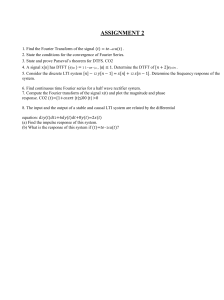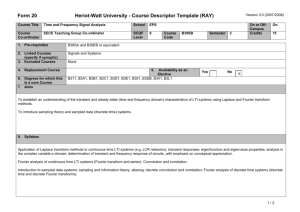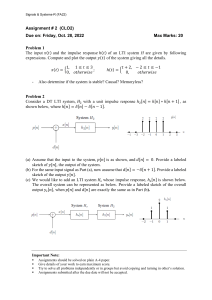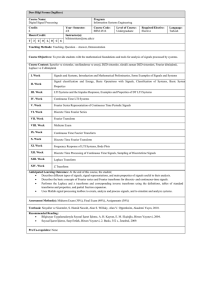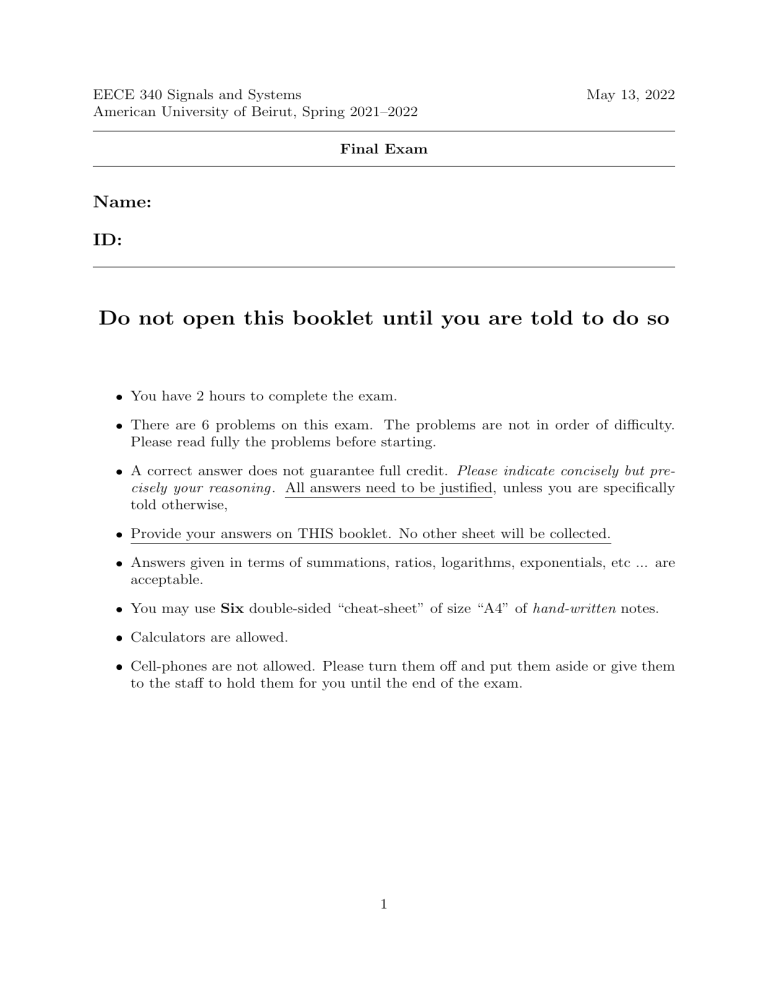
EECE 340 Signals and Systems American University of Beirut, Spring 2021–2022 May 13, 2022 Final Exam Name: ID: Do not open this booklet until you are told to do so You have 2 hours to complete the exam. There are 6 problems on this exam. The problems are not in order of difficulty. Please read fully the problems before starting. A correct answer does not guarantee full credit. Please indicate concisely but precisely your reasoning. All answers need to be justified, unless you are specifically told otherwise, Provide your answers on THIS booklet. No other sheet will be collected. Answers given in terms of summations, ratios, logarithms, exponentials, etc ... are acceptable. You may use Six double-sided “cheat-sheet” of size “A4” of hand-written notes. Calculators are allowed. Cell-phones are not allowed. Please turn them off and put them aside or give them to the staff to hold them for you until the end of the exam. 1 Problem F.1: (10 points) Do any 2 of the 4 questions from (a) through (d). Note that the various parts are independent. Do all for extra credits. (a) A discrete time LTI system is described by the following linear difference equation y[n] = 1 x[n − 1] + x[n − 2] + x[n − 4] − y[n − 1] − y[n − 2] − y[n − 3] − y[n − 4] 5 (i) Determine the output of this system if x[n] = (−1)n for all n. (ii) Determine the output of this system if 2, n even; x[n] = 1, n odd. Answer: 2 (b) You are given a DT system where the Fourier transforms of the output Y ej2πf is related to that of the input by Y e j2πf = Z f + 81 f − 81 X ej2πf df. Determine an expression relating y[n] to x[n]. Answer: 3 (c) Given a discrete time system whose input is x[n] and output is y[n]. The Fourier transforms satisfy the following equation dX ej2πf −j2πf j2πf j2πf j2πf − +e X e = 3X e Y e df (i) Is this system linear? Justify clearly or show a counterexample. (ii) Is this system Time-invariant? Justify clearly or show a counterexample. (iii) Determine the output y[n] if the input is x[n] = δ[n]. Answer: 4 (d) The following facts are known about a discrete time signal with a Z-transform X(z). • x[n] is real and right sided. • X(z) has only two poles. • X(z) has two zeros at the origin. • X(z) has one pole at z = 21 ejπ/3 . • X(1) = 34 . Determine X(z) and its region of convergence. Answer: 5 Problem F.2: (5 points) Given a CT LTI system with input x(t) = e−(t+2) u(t + 2) and impulse response h(t) = e−3t u(t). Determine the output y(t). Answer: 6 Problem F.3: (36 points) Part I: Consider the signal x(t) whose Fourier transform is drawn below: X(f ) ✻ 2 1 0.5 ✲ −2 −1 0 1 2 3 4 f (a) Find the value of x(0), preferably without computing x(t). Z ∞ x(t) dt, preferably without computing x(t). (b) Find the value of −∞ (c) Is x(t) real? Explain, preferably without computing x(t). (d) Find the angle of x(t) for all t, preferably without computing x(t) fully. (e) Determine x(t). Answer: 7 Part II: Mildly dependent on Part I Consider the signal y(t) whose Fourier transform is periodic with period equal to “7” and drawn below: Y (f ) 2 ✻ 1 0.5 −2 −1 0 ✲ 1 2 3 4 5 6 7 8 9 (f) Find the relationship between y(t) and x(t) defined in Part I? (g) Find the value of y(0). Is your answer sensible? Explain. R∞ (h) Find the value of −∞ y(t) dt. Is your answer sensible? Explain. R∞ (i) Find the value of −∞ |y(t)|2 dt. Is your answer sensible? Explain. Answer: 8 10 11 f Part III: Mildly dependent on Part I You decide to sample x(t) (defined in Part I) every T seconds. (j) What is the minimum rate at which you should sample in order to be able to recover x(t)? Explain. (k) What is the DTFT of the sequence of samples y[n] = ˆ x(nT )? (l) Explain how you would reconstruct x(t) from the sequence y[n]. Make sure to specify how the reconstruction is done in the time domain. Answer: 9 Problem F.4: (20 points) A causal DT LTI system is described by the following system function: Y (z) z+3 = H(z) = 2 . X(z) z +z (a) What are the poles of H(z)? Is the system stable? (b) Find the output y[n] of the corresponding system for an input x[n] = 4 × (2)n u[n]. (c) Find the output y[n] of the corresponding system for an input x[n] = 4 × (2)n . (d) Draw a Direct Form II - block diagram for the system at hand. (e) Determine the impulse response of the system. (f) (Bonus) Determine a “minimal” state-space representation of the system. Answer: 10 11 Problem F.5: (20 points) A causal LTI system is described by the differential equation ÿ(t) + ẏ(t) + cy(t) = 2ẋ(t) + x(t), that relates its input x(t) to its output y(t), and where c is a real scalar parameter. (a) Draw an appropriate block diagram for the system at hand. (b) Find its transfer function when it is (initially) at rest. (c) Find the range of the parameter c for which the system is stable. (d) Find its impulse response (for any/all values of c). (e) Find the Zero Input Response (ZIR) of the system when ẏ(0) = 1 and all other values are zero. (f) (Bonus) Write a “minimal” state-space representation of the system. Answer: 12 13 Problem F.6: (30 points) For the following signals, determine an “appropriate” Fourier quantity for the given signal. (a) x(t) = e−2|t| cos(3t) (b) x(t) = sinc3 (t) |n| u[−n − 3] (c) x[n] = 12 (d) x[n] = cos πn + sin(n) 2 (e) The periodic signal shown below: x(t) ✻ 1 ✲ −4 −3 −2 −1 1 2 3 4 −1 (e) The periodic signal shown below: x[n] ✻ 2 ✲ 0 1 2 3 4 5 6 7 8 Answer: 14 n t 15 16
